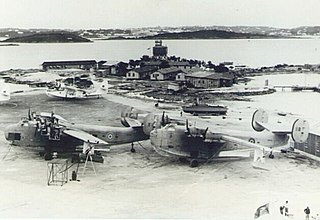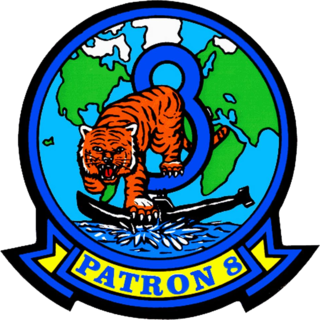
While Bermuda technically remains the responsibility of the government of the United Kingdom, rather than of the local Bermudian Government, the island still maintains a militia for the purpose of defence.
The destroyers-for-bases deal was an agreement between the United States and the United Kingdom on September 2, 1940, according to which 50 Caldwell, Wickes, and Clemson class US Navy destroyers were transferred to the Royal Navy from the US Navy in exchange for land rights on British possessions.

Kindley Air Force Base was a United States Air Force base in Bermuda from 1948–1970, having been operated from 1943 to 1948 by the United States Army Air Forces as Kindley Field.

The Royal Air Force (RAF) operated from two locations in the Imperial fortress colony of Bermuda during the Second World War. Bermuda's location had made it an important naval station since US independence, and, with the advent of the aeroplane, had made it as important to trans-Atlantic aviation in the decades before the Jet Age. The limited, hilly land mass had prevented the construction of an airfield, but, with most large airliners in the 1930s being flying boats, this was not initially a limitation.
The Netherlands Naval Aviation Service is the naval aviation branch of the Royal Netherlands Navy.

Naval Air Station Bermuda, was located on St. David's Island in the British Colony of Bermuda from 1970 to 1995, on the former site of Kindley Air Force Base. It is currently the site of Bermuda International Airport.

Naval Air Station Key West, is a naval air station and military airport located on Boca Chica Key, four miles (6 km) east of the central business district of Key West, Florida, United States.

USS Gannet (AM-41) was an Lapwing-class minesweeper built for the United States Navy near the end of World War I.

The Airport Security Police is the police force of the Bermuda International Airport.

Patrol Squadron Eight (VP-8) is a U.S. Navy land-based patrol squadron stationed at Naval Air Station Jacksonville, Florida (USA). VP-8 is tasked to undertake maritime patrol, anti-submarine warfare (ASW), and intelligence, surveillance and reconnaissance (ISR) missions. The Squadron is equipped with the Boeing P-8A Poseidon.

The United States Naval Station Whites Island was a United States Navy (USN) facility located on White's Island in Hamilton Harbour, in the British Colony of Bermuda, 640 miles off the coast of North Carolina.

The Bermuda Base Command was a command of the United States Army, established to defend the British Colony of Bermuda, located 640 miles off Cape Hatteras, North Carolina. It was created in April 1941 when United States Army troops were sent to the island.

VP-49 was a long-lived Patrol Squadron of the U.S. Navy, having held that designation for 45 years from 1948 to 1994. Its nickname was the Woodpeckers from 1973 to 1994. It was established as VP-19 on 1 February 1944, redesignated Patrol Bombing Squadron VPB-19 on 1 October 1944, redesignated VP-19 on 15 May 1946, redesignated Medium Patrol Squadron (Seaplane) VP-MS-9 on 15 November 1946, redesignated VP-49 on 1 September 1948 and disestablished 1 March 1994.
773 Naval Air Squadron was a Naval Air Squadron of the Royal Navy's Fleet Air Arm.

HMS Castle Harbour was a civilian harbour vessel of 730 tons that was taken-up from trade (TUFT) during the Second World War by the Royal Naval Dockyard in Bermuda for use by the Royal Naval Examination Service and later armed and commissioned as a warship, providing harbour defence from submarines.

US Naval Advance Bases were built globally by the United States Navy during World War II to support and project U.S. naval operations world-wide. A few were built on allied soil, but most were captured enemy facilities or completely new. Advance bases provided the fleet with support to keep ships tactically available with repair and supply depots of facilities, rather than return them to continental United States. Before Japan declared war on the United States the US Navy had a single fleet sized advanced base in the Territory of Hawaii. It was Naval Station Pearl Harbor. During the war the US Navy Seabees built over 400 advance bases categorized by size. Naval bases were either Lions or Cubs while airfields were either Oaks or Acorns. Lions and Oaks were major facilities while Cubs and Acorns were minor. PT Boats typically would get a Cub and airfields with single runways were Acorns. The larger bases could do refueling and overhaul; loading of troopship and cargo ships; and preparing amphibious assault ships. Some became major repair depots. The Seabees developed auxiliary floating drydocks were able to repair battle damage and do regular maintenance in the field saving ships trans-pacific trips for repair. A few bases also were developed to be R and R for all U.S. personnel. Most Advance Bases were built by the US Navy's Seabees in Naval Construction Battalions (CBs). At the start of the war some civilian contractor were employed in construction. The Seabees in World War II built most of the airfields used by the United States Army Air Forces and United States Marine Corps, as they had the ships and cranes needed to transport the vast amount of equipment needed at the advance bases. The US Army and United States Coast Guard also operated out of many of these facilities. Seabees could build new or repair damaged runways, and with advancements in heavy bomber technology lengthen runways as needed. A few Naval Advance Bases were built for the Korean War and Vietnam War.

RNAS Bermuda was a Royal Naval Air Station in the Royal Naval Dockyard on Ireland Island until 1939, then Boaz Island, Bermuda. Bermuda became the primary base for the North America and West Indies Station of the Royal Navy in the North-West Atlantic following American independence. It was the location of a dockyard, an Admiralty House, and the base of a naval squadron.

Naval Base Trinidad, also called NAS Trinidad, NAS Port-of-Spain, was a large United States Navy Naval base built during World War II to support the many naval ships fighting and patrolling the Battle of the Atlantic. The fighting in the area became known as the Battle of the Caribbean. Naval Base Trinidad was located on the Island of Trinidad in West Indies of the Caribbean Sea.

Carrier Aircraft Service Units (CASU) were United States Navy units formed during World War II for the Pacific War to support naval aircraft operations. From 1942 to 1946, 69 Carrier Aircraft Service Units were formed to repair and maintain aircraft. The first unit was deployed to Naval Station Pearl Harbor. The CASU-11, was deployed on January 22, 1943 at Naval Air Station San Diego. During the war the Navy lacked enough aircraft carriers to complete all the operational requirements. Aircraft mechanics of Carrier Aircraft Service Units traveled with the island hopping troops as new airfields were built across the Western Pacific Ocean. The many aircraft fighting and patrolling the South West Pacific theatre of war needed ongoing maintenance. CASU-11 was deployed for three years and nine months. CASU-11 decommissioned on November 1, 1946 at Naval Air Facility Yonabaru Okinawa with the war over. In that time CASU-11 traveled over 1,700 troops worked in CASU-11 and the unit traveled over 27,000 miles. CASU-11 worked on Naval planes at Naval Air Stations from Guadalcanal to Okinawa. Carrier Aircraft Service Units worked on seaplanes, fighter planes, bombers torpedo planes, dive bombers, and later night fighters. Out of necessity Carrier Aircraft Service Units sometimes worked on marine craft, United States Army Air Forces and other allied aircraft. Carrier Aircraft Service Units worked on aircraft carrier planes and land-based planes. Some Carrier Aircraft Service Units worked in United States on training aircraft and other planes. If needed a Carrier Aircraft Service Unit could be redesignated into a Combat Aircraft Service Unit, Scout Observation Service unit or Patrol Service units.

Naval Base Brisbane was a major United States Navy base built in the early part of World War II at Brisbane, Queensland, Australia. At first, operated as a base for patrol aircraft and convoy escort aircraft to protect the last leg of the Pacific War to the Southwest Pacific. As the US Navy expanded in the island hopping campaign, Naval Base Brisbane expanded to include a submarine base, repair depot, seaplane base and other facilities. US Navy operations started on April 14, 1942, and ended after the war in 1945.


















